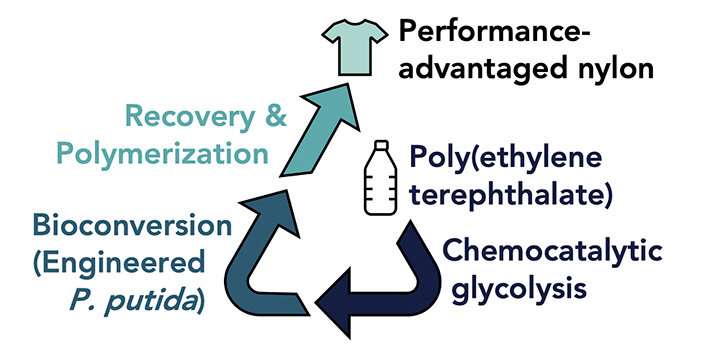Researchers engineer microorganisms to tackle PET plastic pollution

From overflowing landfills to floating garbage islands in the oceans to microplastics in remote wilderness areas, billions of tons of discarded plastic have created a global pollution crisis.
Although plastics are essential to our everyday lives, they are durable materials that do not naturally biodegrade, taking decades or even centuries to decompose in landfills or the natural environment. More than 82 million metric tons of polyethylene terephthalate (PET) is produced globally each year to make single-use beverage bottles, packaging, clothing, and carpets, and it is one of the largest sources of plastic waste.
Scientists from the U.S. Department of Energy’s (DOE’s) National Renewable Energy Laboratory (NREL) are making progress on a possible solution to PET waste. A collaborative research team is combining chemistry and biology to turn PET into a nylon material with better properties that can be used to create a more versatile range of new products.
In conjunction with the Bio-Optimized Technologies to keep Thermoplastics out of Landfills and the Environment (BOTTLE) Consortium, NREL researchers and partners from Oak Ridge National Laboratory (ORNL) engineered a bacterium to convert deconstructed PET into building blocks for a superior nylon product. As described in “Tandem chemical deconstruction and biological upcycling of poly(ethylene terephthalate) to β-ketoadipic acid by Pseudomonas putida KT2440,” recently published in Metabolic Engineering, these high-performance monomers can then be recycled into higher-value plastic materials and products, a process known as upcycling.
“This biological conversion step is one important part of the equation that makes PET upcycling possible, creating the opportunity to turn polluting plastic bottles into prized manufacturing materials, ultimately moving us closer to a circular economy at scale,” said NREL scientist and journal article first author Allison Werner.
A circular economy can extend the functional lifespan of the molecules to make virgin plastics, while reducing waste, conserving resources, and boosting efficiency. This can help deliver supplies that are manufactured using less raw material and energy and stay out of landfills.
BOTTLE researchers are exploring how a range of chemical and biological processes can be used to deconstruct plastic wastes and upcycle them to higher-value, recyclable materials. The recent BOTTLE project deconstructed PET using a chemo-catalytic process and engineered the bacterium Pseudomonas putida KT2440 to convert the PET into the chemical β-ketoadipic acid (βKA), a building block for performance-advantaged nylon.
NREL and ORNL collaborated in engineering the bacteria. ORNL engineered the bacteria to utilize a key intermediate in PET breakdown, which enabled the NREL team to build a complete platform for bioconversion.
Dealing with problem PET
Each type of plastic has its own molecular properties that potentially require different methods to deconstruct. PET can be deconstructed to monomers using several different chemical processes. However, the mechanical methods used for the majority of PET recycling today can result in poor quality and less profitable products, leading to low recycling rates. Various sources show that currently only 15% to 35% of all PET bottles find a second life.
The biological transformations engineered by NREL and ORNL scientists into P. putida, paired with a chemo-catalytic glycolysis process, can create a more valuable product from PET and ultimately incentivize higher reclamation rates—eventually translating into fewer discarded plastic bottles polluting ocean waters and mountain wilderness areas.
The material extracted through this tandem catalytic deconstruction and biological conversion technique offers better properties than the common types of nylon it is intended to replace, including lower water permeability, higher melt temperature, and higher glass transition temperature. These performance advantages expand the ways the material can be used, including for automotive parts that need to withstand high temperatures. Increased value of the recycled material could incentivize industry to recycle more plastic, leading to plastic recovery on a much larger scale.
Refusing to roll over on plastic pollution
While this initial breakthrough already promises to expand opportunities for PET upcycling, researchers continue to refine the approach. In addition to optimizing the chemistry-biology interface, the team is evaluating a wide range of other factors.
Postconsumer PET waste streams can contain additives that P. putida may be unable to catabolize. Characterization of these streams to identify the chemicals present and engineering metabolic pathways to enable consumption of these compounds as well will be needed to maximize efficiency of the bioconversion process, increase yields, and comprehensively deal with the plastic waste.
The future success of any tandem deconstruction and upcycling approach for PET will ultimately be determined by its combined technical feasibility, economic viability, and environmental impact. The NREL team plans to perform techno-economic analysis and life cycle assessment to build a better understanding of the process energy requirements and greenhouse gas emissions.
“Plastics have revolutionized modern life, but, until recently, plastic manufacturing has followed a strictly linear economy and is carbon-intensive,” said NREL Senior Research Fellow, BOTTLE Consortium Lead, and journal article senior author Gregg Beckham. “Circular approaches to this problem can reduce our reliance on fossil-based carbon and thus reduce greenhouse gas emissions. With annual plastic production expected at nearly 600 million tons by 2050, the time to act is now.”
The efforts of NREL and the BOTTLE Consortium, including these new chemical deconstruction and biological upcycling techniques, will be vital tactics in combatting the plastic pollution crisis and the environmental and energy challenges associated with climate change.
Allison Z. Werner et al, Tandem chemical deconstruction and biological upcycling of poly(ethylene terephthalate) to β-ketoadipic acid by Pseudomonas putida KT2440, Metabolic Engineering (2021). DOI: 10.1016/j.ymben.2021.07.005
Citation:
Researchers engineer microorganisms to tackle PET plastic pollution (2021, October 14)
retrieved 14 October 2021
from https://phys.org/news/2021-10-microorganisms-tackle-pet-plastic-pollution.html
This document is subject to copyright. Apart from any fair dealing for the purpose of private study or research, no
part may be reproduced without the written permission. The content is provided for information purposes only.
For all the latest Science News Click Here
For the latest news and updates, follow us on Google News.

